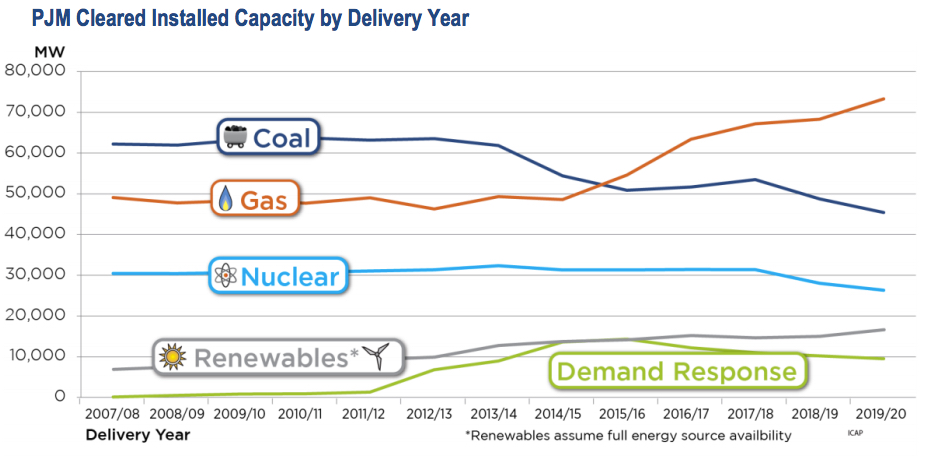
In a thinly-veiled swipe at renewable energy resources, Energy Secretary Rick Perry is reportedly ordering a study to determine whether the proliferation of renewables is threatening grid reliability by causing baseload (i.e., coal) resources to retire prematurely. The target of the report is not renewables, per se, but rather the compensation scheme for wholesale power in restructured markets around the country, and whether these markets are over or under-compensating various resources and therefore resulting in a sub-optimal fuel mix.
The subjects of generator compensation and fuel diversity are hotly contested in the energy world, as new (and renewable) resources such as wind, solar, and storage seek to compete with traditional resources such as gas, coal, and even nuclear. These new resources, which are favored by regulators in many states (including Perry’s home state of Texas), to date have generally complemented the existing resource mix and grid operators have been able to balance increasing quantities of intermittent resources; while industry insiders have debated the merits and value of various resource types, for the most part these arguments have taken place outside of the spotlight.
Now, though, with the new administration’s efforts to support coal power, along with nuclear operators loudly arguing their plants are being under-compensated and threatening shutdowns in New York, Illinois, and Ohio, and also as wind and solar generation reach ever higher levels of penetration and threaten to upend the historical pricing and production models in states such as California and Hawaii, the fight for the future of the grid is bursting into the headlines.
The Federal Energy Regulatory Commission next month will be holding a technical conference, during which Commission staff seeks to discuss long-term expectations regarding the relative roles of wholesale markets and state policies in the Eastern RTOs/ISOs in shaping the quantity and composition of resources needed to cost-effectively meet future reliability and operational needs.
Testimony for the technical conference will be forthcoming, but in the meantime the nation’s largest electrical grid, PJM Interconnection, has issued a report concluding that today’s resource profile “is both reliable and diverse,” and that not only does a more diverse grid not threaten reliability, “[t]he expected near-term resource portfolio is among the highest-performing portfolios and is well equipped to provide the generator reliability attributes.”
As the resource mix moves in the direction of less coal and nuclear generation, according to PJM, generator reliability attributes of frequency response, reactive capability, and fuel assurance decrease, but flexibility and ramping attributes increase. With regard to solar capacity, PJM concludes that this resource cannot feasibly exceed 20 percent of the mix due to unavailability at night. That said, assuming other nighttime resources, PJM “could maintain reliability with unprecedented levels of wind and solar.”
As for the grid’s reliance on individual fuels, PJM advises that heavy reliance on any one fuel type may negatively impact resilience. For example, gas plants can generally be relied upon to serve up to 86 percent of demand, but risks include interruptions in fuel deliverability in extreme conditions such as a polar vortex; for coal plants, operational risks include coal piles freezing or an inability to replenish coal supplies in extreme conditions.
The resource mix within PJM has become more evenly balanced in recent years. In 2005, coal and nuclear resources generated 91 percent of the electricity on the PJM system. Over time, policy initiatives, technology improvements, and economics spurred a shift from coal to natural gas and renewable generation. From 2010 to 2016 in PJM, coal-fired units made up 79 percent of the megawatts retired, and natural gas and renewables made up 87 percent of new megawatts placed in service. PJM’s installed capacity in 2016 consisted of 33 percent coal, 33 percent natural gas, 18 percent nuclear, and 6 percent renewables (including hydro).
Without identifying the optimal resource mix, PJM concludes that “there are resource blends between the most diverse and the least diverse portfolios which provide the most generator reliability attributes.”
I invite you to view my other posts and sign up to receive future posts via email. I also invite you to follow me on LinkedIn and Twitter, and to contact me via my homepage.
